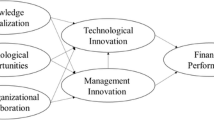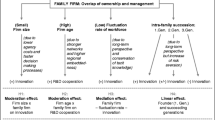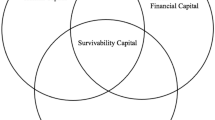Abstract
This study provides an exploratory analysis of differences between family and non-family firms in innovation investment, product and process innovation outcomes, and labor productivity. Using data from the Community Innovation Survey on 2,087 German small- and medium-sized enterprises (SMEs), we observe significant disparities at each stage of the innovation process. Whereas family SMEs have a higher propensity to invest in innovation at all, conditional on investing in innovation, these companies do so less intensively than their non-family counterparts. Family SMEs further tend to outperform non-family SMEs in terms of process innovation outcomes when controlling for innovation investment. Given the level of product and process innovation, however, family SMEs underperform regarding labor productivity in comparison to non-family SMEs. These findings complement previous empirical research by illustrating how the presence of a dominant family relates to innovation inputs and outputs of SMEs in Europe’s largest economy and its innovative SME sector.
Similar content being viewed by others
Notes
According to the Stiftung Familienunternehmen (2011), the share of family firms in Germany (based on the definition that a family owns the majority of shares or votes in a firm) varies as follows across different size classes (number of employees): 0–9: 94 %, 10–49: 85 %, 50–249: 58 %, 250–499: 36 %, and >500: 27 %.
See Mairesse and Mohnen (2010) for an overview of recent studies using the CDM model.
In accordance with the CIS, we define innovation expenditures as money spent on internal and external R&D or the acquisition of external resources to realize innovation projects.
To check the robustness of our results, we reran the entire model adopting the definition of SMEs used in the US (10–500 employees). The sample size increases from 2,087 to 2,323 firms but there is no qualitative difference in the results; all family SME effects are confirmed.
Specifically, this encompasses all internal and external R&D expenditures, acquisition of advanced machinery, facilities, software and external knowledge to realize innovation projects, product design, construction, design of services and other preparations for the production/sale and distribution of innovations, internal or external training specifically for innovation projects, and launch of innovations onto the market (marketing campaigns directly linked to product innovations). Organizational innovation is not included.
Without any loss of generality, we assume that the threshold is zero.
Using the same set of regressors in the selection and the outcome equation of the Heckman model requires the selection equation to be non-linear (Cameron and Trivedi 2010). Testing for this we found clear evidence for non-linearity indicating that the identification of our model need not rely on exclusion restrictions.
Even 20 years after reunification, structural economic differences still persist between the formerly separate entities of East and West Germany. Hence, we control for these regional differences within our analysis.
In addition to the variables discussed in the text, we have included dummy variables for several control variables that indicate missing values. In all cases, when the missing values indicator has a value of one, the corresponding variable is coded zero.
References
Ang, J. S., Cole, R. A., & Lin, J. W. (2000). Agency costs and ownership structure. Journal of Finance, 55(1), 81–106.
Astrachan, J. H., & Shanker, M. C. (1996). Myths and realities: Family businesses’ contribution to the US economy—A framework for assessing family business statistics. Family Business Review, 9(2), 107–119.
Atuahene-Gima, K. (1996). Market orientation and innovation. Journal of Business Research, 35(2), 93–103.
Audretsch, D. B. (2002). The dynamic role of small firms: Evidence from the U.S. Small Business Economics, 18(1–3), 13–40.
Ayyagari, M., Demirgüç-Kunt, A., & Vojislav, M. (2011). Firm innovation in emerging markets: The role of finance, governance, and competition. Journal of Financial and Quantitative Analysis, 46(6), 1545–1580.
Barbera, F., & Moores, K. (2013). Firm ownership and productivity: A study of family and non-family SMEs. Small Business Economics, 40(4), 953–976.
Barth, E., Gulbrandsen, T., & Schone, P. (2005). Family ownership and productivity: The role of owner-management. Journal of Corporate Finance, 11(1–2), 107–127.
Beehr, T. A., Drexler, J. A., Jr, & Faulkner, S. (1997). Working in small family businesses: Empirical comparisons to non-family businesses. Journal of Organizational Behavior, 18(3), 297–312.
Benavides-Velasco, C., Quintana-García, C., & Guzmán-Parra, V. (2013). Trends in family business research. Small Business Economics, 40(1), 41–57.
Bennedsen, M., Nielson, K. M., Pérez-González, F., & Wolfenzon, D. (2007). Inside the family firm: The role of families in succession decisions and performance. Quarterly Journal of Economics, 122(2), 647–691.
Block, J. H. (2010). Family management, family ownership, and downsizing: Evidence from S&P 500 firms. Family Business Review, 23(2), 109–130.
Block, J. H. (2012). R&D investments in family and founder firms: An agency perspective. Journal of Business Venturing, 27(2), 248–265.
Block, J., Miller, D., Jaskiewicz, P., & Spiegel, F. (2013). Economic and technological importance of innovations in large family and founder firms: An analysis of patent data. Family Business Review, 26(2), 180–199.
Cameron, A. C., & Trivedi, P. K. (2010). Microeconometrics using stata (2nd ed.). College Station: Stata Press.
Carroll, G. R., & Hannan, M. T. (2000). The demography of corporations and industries. Princeton, NJ: Princeton University Press.
Cefis, E., & Marsili, O. (2006). Survivor: The role of innovation in firms’ survival. Research Policy, 35(5), 626–641.
Chen, H. L., & Hsu, W. T. (2009). Family ownership, board independence and R&D investment. Family Business Review, 22(4), 347–362.
Chin, C. L., Chen, Y. J., Kleinman, G., & Lee, P. (2009). Corporate ownership structure and innovation: Evidence from Taiwan’s electronics industry. Journal of Accounting Auditing Finance, 24(1), 145–175.
Chrisman, J. J., Chua, J. H., Pearson, A. W., & Barnett, T. (2012). Family involvement, family influence, and family-centered non-economic goals in small firms. Entrepreneurship Theory and Practice, 36(2), 267–293.
Chrisman, J. J., Chua, J. H., & Sharma, P. (2005). Trends and directions in the development of a strategic management theory of the family firm. Entrepreneurship Theory and Practice, 29(5), 555–576.
Chrisman, J. J., & Patel, P. J. (2012). Variations in R&D investments of family and non-family firms: Behavioral agency and myopic loss aversion perspectives. Academy of Management Journal, 55(4), 976–997.
Chu, W. (2009). The influence of family ownership on SME performance: Evidence from public firms in Taiwan. Small Business Economics, 33(3), 353–373.
Chua, J. H., Chrisman, J. J., & Sharma, P. (1999). Defining the family business by behavior. Entrepreneurship Theory and Practice, 23(4), 19–39.
Classen, N., Van Gils, A., Bammens, Y., & Carree, M. (2012). Accessing resources from innovation partners: The search breadth of family SMEs. Journal of Small Business Management, 50(2), 191–215.
Craig, J. B. L., & Dibrell, C. (2006). The natural environment, innovation, and firm performance: A comparative study. Family Business Review, 19(4), 275–288.
Crépon, B., Duguet, E., & Mairesse, J. (1998). Research and development, innovation and productivity: An econometric analysis at the firm level. Economics of Innovation and New Technology, 7(2), 115–158.
Cruz, C., Justo, R., & De Castro, J. (2012). Does family employment enhance MSEs performance? Integrating socioemotional wealth and family embeddedness perspectives. Journal of Business Venturing, 27(1), 62–76.
Czarnitzki, D., & Kraft, K. (2009). Capital control, debt financing and innovative activity. Journal of Economic Behavior & Organization, 71(2), 372–383.
De Massis, A., Frattini, F., & Lichtenthaler, U. (2013a). Research on technological innovation in family firms: Present debates and future directions. Family Business Review, 26(1), 10–31.
De Massis, A., Frattini, F., Pizzurno, E., & Cassia, L. (2013b). Product innovation in family vs. non-family firms: An exploratory analysis. Journal of Small Business Management, 51(4).
De Massis, A., Sharma, P. A., Chua, J. H., & Chrisman, J. J. (2012). Family business studies: An annotated bibliography. Northhampton, MA: Edward Elgar.
Eddleston, K. A., & Kellermanns, F. W. (2006). Destructive and productive family relationships: A stewardship theory perspective. Journal of Business Venturing, 22(4), 545–565.
Eddleston, K. A., Kellermanns, F. W., & Sarathy, R. (2008). Resource configuration in family firms: Linking resources, strategic planning and technological opportunities to performance. Journal of Management Studies, 45(1), 26–50.
Esteve-Pérez, S., & Mañez-Castillejo, J. A. (2008). The resource-based theory of the firm and firm survival. Small Business Economics, 30(3), 231–249.
European Commission. (2012). SBA Fact Sheet 2012: Germany. Retrieved December 2, 2012, from The World Wide Web: http://ec.europa.eu/enterprise/policies/sme/facts-figures-analysis/performance-review/files/countries-sheets/2012/germany_en.pdf.
Gómez-Mejía, L. R., Cruz, C., Berrone, P., & De Castro, J. (2011). The bind that ties: Socioemotional wealth preservation in family firms. The Academy of Management Annals, 5(1), 653–707.
Gómez-Mejía, L. R., Hynes, K. T., Núñez-Nickel, M., Jacobson, K. J. L., & Moyano-Fuentes, H. (2007). Socioemotional wealth and business risk in family-controlled firms: Evidence from Spanish olive oil mills. Administrative Science Quarterly, 52(1), 106–137.
Griffith, R., Huergo, E., Mairesse, J., & Peters, B. (2006). Innovation and productivity across four European countries. Oxford Review of Economic Policy, 22(4), 483–498.
Gudmundson, D., Tower, C. B., & Hartman, E. A. (2003). Innovation in small businesses: Culture and ownership structure do matter. Journal of Developmental Entrepreneurship, 8(1), 1–18.
Habbershon, T., Williams, M., & MacMillan, I. (2003). A unified systems perspective of family firm performance. Journal of Business Venturing, 18(4), 451–465.
Hall, B. H., Lotti, F., & Mairesse, J. (2009). Innovation and productivity in SMEs: Empirical evidence for Italy. Small Business Economics, 33(1), 13–33.
Hannan, M. T., & Freeman, J. (1984). Structural inertia and organizational change. American Sociological Review, 49(2), 149–164.
Heckman, J. (1979). Sample selection bias as a specification error. Econometrica, 47(1), 153–161.
Holderness, C. G., & Sheehan, D. P. (1988). The role of majority shareholders in publicly held corporations: An exploratory analysis. Journal of Financial Economics, 20(1–2), 317–346.
Kellermanns, F., Eddleston, K., Sarathy, R., & Murphy, F. (2012). Innovativeness in family firms: A family influence perspective. Small Business Economics, 38(1), 85–101.
Klein, S. B. (2000). Family businesses in Germany: Significance and structure. Family Business Review, 13(3), 157–181.
König, A., Kammerlander, N., & Enders, A. (forthcoming). The family innovator’s dilemma: How family influence affects the adoption of discontinuous technologies by incumbent firms. Academy of Management Review. doi:10.5465/amr.2011.0162.
Latham, S. F., & Braun, M. (2009). Managerial risk, innovation and organizational decline. Journal of Management, 35(2), 258–281.
Lööf, H., & Heshmati, A. (2002). Knowledge capital and performance heterogeneity: A firm level innovation study. International Journal of Production Economics, 76(1), 61–85.
Lööf, H., & Heshmati, A. (2006). On the relationship between innovation and performance: A sensitivity analysis. Economics of Innovation and New Technology, 15(4–5), 317–345.
Mairesse, J., & Mohnen, P. (2010). Using innovation surveys for econometric analysis. In B. H. Hall & N. Rosenberg (Eds.), Handbook of the economics of innovation (pp. 1130–1155). Amsterdam: Elsevier.
Martikainen, M., Nikkinen, J., & Vähämaa, S. (2009). Production functions and productivity of family firms: Evidence from the S&P 500. The Quarterly Review of Economics and Finance, 49(2), 295–307.
Maury, B. (2006). Family ownership and firm performance: Empirical evidence from Western European corporations. Journal of Corporate Finance, 12(2), 321–341.
McConaughy, D. L., Walker, M. C., Henderson, G. V., & Mishra, C. S. (1998). Founding family controlled firms: Efficiency and value. Review of Financial Economics, 7(1), 1–19.
Miller, D., Le Breton-Miller, I., & Lester, R. (2011). Family and lone-founder ownership and strategic behavior: Social context, identity and institutional logics. Journal of Management Studies, 48(1), 1–25.
Miller, D., Le Breton-Miller, I., & Lester, R. (2013). Family firm governance, strategic conformity, and performance: Institutional vs. strategic perspectives. Organization Science, 24(1), 189–209.
Monopolkommission. (2008). Weniger Staat, mehr Wettbewerb: Gesundheitsmärkte und staatliche Beihilfen. Hauptgutachten XVII (2006/2007), Nomos, Baden–Baden.
Morck, R., & Yeung, B. (2003). Agency problems in large family business groups. Entrepreneurship Theory and Practice, 27(4), 367–382.
Munari, F., Oriani, R., & Sobrero, M. (2010). The effects of owner identity and external governance systems on R&D investments: A study of Western European firms. Research Policy, 39(8), 1093–1104.
Muñoz-Bullón, F., & Sanchez-Bueno, M. J. (2011). The impact of family involvement on the R&D intensity of publicly traded firms. Family Business Review, 24(1), 62–70.
Naldi, L., Nordqvist, M., Sjöberg, K., & Wiklund, J. (2007). Entrepreneurial orientation, risk taking, and performance in family firms. Family Business Review, 20(1), 33–47.
OECD, & Eurostat. (2005). Oslo manual: Guidelines for collecting and interpreting innovation data (3rd ed.). Paris: Organisation for Economic Co-operation and Development, Statistical Office of the European Communities.
Patel, P. C., & Chrisman, J. J. (forthcoming). Risk abatement as a strategy for R&D investments in family firms. Strategic Management Journal. doi:10.1002/smj.2119.
Peters, B. (2008). Innovation and firm performance: An empirical investigation for German firms. ZEW Economic Studies, 38, Physica Heidelberg, New York.
Roper, S. (1997). Product innovation and small Business growth: A comparison of the strategies of German, U.K. and Irish companies. Small Business Economics, 9(6), 523–537.
Rosenbusch, N., Brinckmann, J., & Bausch, A. (2011). Is innovation always beneficial? A meta-analysis of the relationship between innovation and performance in SMEs. Journal of Business Venturing, 26(4), 441–457.
Shi, C. (2003). On the trade-off between the future benefits and riskiness of R&D: A bondholders’ perspective. Journal of Accounting and Economics, 35(2), 227–254.
Shipton, H., West, M., Dawson, J., Birdi, K., & Patterson, M. (2006). HRM as a predictor of innovation. Human Resource Management Journal, 16(1), 3–27.
Simon, H. (2009). Hidden champions of the 21st century: Success strategies of unknown world market leaders. London: Springer.
Sirmon, D. G., & Hitt, M. A. (2003). Managing resources: Linking unique resources, management and wealth creation in family firms. Entrepreneurship Theory and Practice, 27(4), 339–358.
Sraer, D., & Thesmar, D. (2007). Performance and behavior of family firms: Evidence from the French stock market. Journal of the European Economic Association, 5(4), 709–751.
Stiftung Familienunternehmen. (2011). Die volkswirtschaftliche Bedeutung von Familienunternehmen, Munich. Retrieved January 7, 2013, from The World Wide Web: http://www.familienunternehmen.de/media/public/pdf/studien/Die_volkswirtschaftliche_Bedeutung_der_Familienunternehmen.pdf.
Terziovski, M. (2010). Innovation practice and its performance implications in small and medium enterprises (SMES) in the manufacturing sector: A resource-based view. Strategic Management Journal, 31(8), 892–902.
Villalonga, B., & Amit, R. (2006). How do family ownership, control, and management affect firm value? Journal of Financial Economics, 80(2), 385–417.
Westhead, P. (1997). Ambitions, external environment and strategic factor differences between family and non-family companies. Entrepreneurship & Regional Development, 9(2), 127–158.
World Economic Forum. (2010). The global competitiveness report 2010–2011. Retrieved April 21, 2013, from The World Wide Web: http://www3.weforum.org/docs/WEF_GlobalCompetitivenessReport_2010-11.pdf.
Zahra, S. A. (2005). Entrepreneurial risk taking in family firms. Family Business Review, 18(1), 23–40.
Zahra, S. A. (2012). Organizational learning and entrepreneurship in family firms: Exploring the moderating effect of ownership and cohesion. Small Business Economics, 38(1), 51–65.
Zellweger, T. M. (2007). Time horizon, costs of equity capital, and generic investment strategies of firms. Family Business Review, 20(1), 1–15.
Zellweger, T. M., Nason, R. S., Nordqvist, M., & Brush, C. G. (2011). Why do family firms strive for nonfinancial goals? An organizational identity perspective. Entrepreneurship Theory and Practice, 37(2), 229–248.
Author information
Authors and Affiliations
Corresponding author
Rights and permissions
About this article
Cite this article
Classen, N., Carree, M., Van Gils, A. et al. Innovation in family and non-family SMEs: an exploratory analysis. Small Bus Econ 42, 595–609 (2014). https://doi.org/10.1007/s11187-013-9490-z
Accepted:
Published:
Issue Date:
DOI: https://doi.org/10.1007/s11187-013-9490-z




